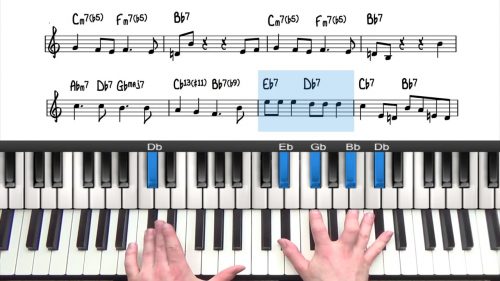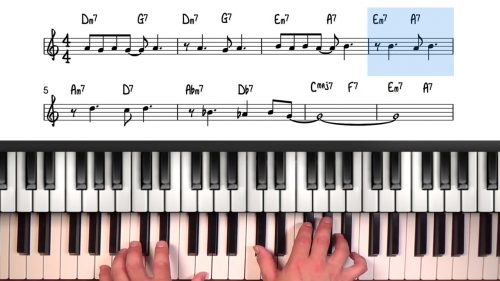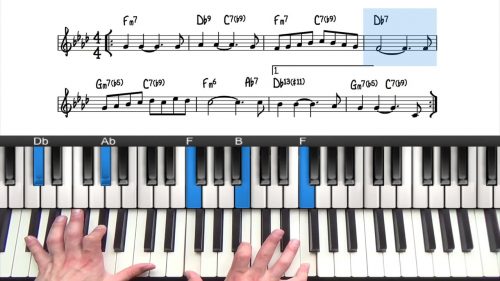In A Sentimental Mood Tutorial
Duke Ellington’s ‘In A Sentimental Mood’ is one of the most recognisable jazz ballads. The tune is very accessible and a great standard to start on for beginneror early intermediate students.
In a Sentimental Mood contains 2 instances of the minor line cliche – both in the first 8 bars. Don’t let the minor-major chords intimidate you… they are easy to play over once you understand what is going on in the harmony! We’ll be looking in depth at how we voice the chords in this common progression. There’s also bits of altered harmony which is nice for practicing upper structures.
In part 1 we are going to play through the form with left hand voicings and examine the chords in the form. In part 2 we will then build some 2 handed voicings incorporating extended and altered chord tones.
Spend some time to practice the left hand voicings covered in this tutorial so that you are comfortable with the melody and harmony. Then move onto part 2 where we will add some bigger voicings and create a fuller sounding arrangement of the tune.
If you have any questions with what I have covered, jut drop it in the comment box below.
Practice Tips
This tune has been widely recorded and there are many brilliant solo piano versions to take inspiration from. At PianoGroove, our favourite recording is the solo piano arrangement by Hank Jones - check out the link to the recording below.
Also check out the other records listed below and remember that you should be listening to jazz every day to help you absorb the feel and articulation of the music.







test
I just did this lesson for the first time and its clear that although I’ve practiced my 2-5-1’s and feel like I know them, when I apply them in the standard they just aren’t falling automatically under my fingers. I have to take the time to mentally build and visualize that left hand voicing. Is this normal…does it just take a lot of repetition in the context of standards for it to become more like muscle memory?
Hey Kim,
Yes this takes time. The progress is slow and sometimes hard to notice but I promise you it comes with time.
Some of the 251s are more common like the 251s in F Major.
But you may find the 251 in Db Major in the bridge much harder though as you may not come across this key as often.
“I have to take the time to mentally build and visualize that left hand voicing. Is this normal” ….
Yes! This is exactly what you should be doing to get the most benefit. You should feel the cogs in your brain grinding together when you are working out the notes. By doing this you will retain the shapes much better, so that when you next come across Eb-7 / Ab7 / Dbmaj7 – your reaction time will be quicker.
The worst thing you can do here is avoid working it out and just skip over it. This will just compound the problem you are facing. Take the time to work it out, then memorise it and slowly build up the tempo.
The more jazz standards you play, the easier this becomes.
Always play through with left hand voicings as an exercise itself.
Remember jazz is hard to learn… if it was easy there would be a tonne of amazing jazz musicians which isn’t the case.
Hope this helps!
Hayden
My pleasure Kim. I actually think that the vast majority of improvement happens when you are sleeping.
So also be conscious not to ‘over-practice’ because you aren’t seeing improvemts in one sitting.
Whichever area is troubling you, practice it at least 4 times perfectly accurately at a slow tempo.
It may just be 2 or 4 bars of a standard that trip you up each time you play though.
Isolate it. Slow it down. Play it perfectly accurately 4 or 8 times. Then move on and come back the next day and speed it back up gradually.
This is a good process to follow and those ‘trouble-areas’ of your tunes will be ironed out in a matter of days.
Try it out :-)
Hayden
Thanks as always Hayden, for the positive reinforcement, and your dedication to helping us students be the best we can be! This is exactly what I needed to hear to confirm that I am on the right track. I’m definitely seeing results…when I played through the lesson for the second time today, I was amazed by the progress that had rooted itself in my “cogs” overnight. I see what you mean about the improvement sometimes happening when you’re away from the piano, very cool! And I found it interesting that my instincts led me to focus more on just playing the left hand voicings with you today and just let the melody go for now
Good day to you Hayden.Só this standard only has a form of ABA?Thks
Hey Ivan 👋
This tune follows an AABA form. So once you have learnt the first 8 bars, you have almost learnt 75% of the tune!
Check out the lesson here on common jazz forms: pianogroove.com/jazz-piano-lessons/common-jazz-forms/
Cheers!
Hayden
Hi Hayden great lesson thankyou, where can I find part 2
please?
Hi Hayden,
Thank you for another great tutorial.
I was able to play the song quite well after 1-2 weeks of practicing which is very short time period for a true beginner such as I :). Also, I’m using the same chords progression with improvising the right hand on the melody by using the scale of the song which I find useful.
I’m curious though why most of the chords are played without the root (for example: the Dm7, Dm(maj7), Gm7,Gmaj7)?
Is there any specific reasons why we don’t include the root of these specific chords?
Thanks.
Ariel.
Hi Ariel 👋
I’m glad you enjoyed the lesson.
Yes this song is nice to practice improvisation. the form is simple and repetitive, and the minor line cliches give a lot of space to experiment with the different minor scales and colours.
To answer your question:
Firstly, in part 2 we introduce bigger voicings that we would play in a solo piano context. Here’s the lesson: pianogroove.com/jazz-piano-lessons/sentimental-mood-tutorial-part-2/ (it’s the next lesson in this course for you)
Now there’s a few of reasons why we didn’t include the roots in this lesson:
1) This theme of this course is rootless voicings and so in the jazz standard lessons I demonstrate how to play through a whole tune with them. When playing with a bass player, that is when we would drop the root and voice the chords in this style. By playing through the whole tune with rootless voicings it prepares us for this scenario.
2) Even when playing solo piano, it can be nice to occasionally leave out the root in a chord to achieve a different textures and colours in our harmonies. This creates more variety in our arrangements. When starting a new tune, I recommend that we also play through with left hand voicings.
3) Finally, when playing a left hand stride style in a solo piano context, it’s common to play the root way down in the lower registers, and then bring our hand up to play a rootless voicing which include extensions and/or alterations. I demonstrate this in the practice series lessons for this course:
Rootless Stride Drill: pianogroove.com/jazz-piano-lessons/rootless-voicings-stride-drill/
and
Rootless 251 Stride Drill: pianogroove.com/jazz-piano-lessons/251-stride-drill-with-rootless-voicings/
By playing through the whole form with rootless voicings, it prepares us for this kind of solo piano style, and helps us to visualise those rootless shapes that we can then apply to our left hand stride.
I’d also recommend checking out this lesson Ariel, one of my 5-min masterclasses where we incorporate this tune: pianogroove.com/jazz-piano-lessons/harmonising-step-wise-melodies/ – it’s more advanced but I think it will give you some new perspective on voicings options, and also reharmonisation.
Before you watch the masterclass, check out Part 2 of this tutorial and that will give you the solo piano arrangement with big rooted voicings. Everything should make more sense then.
If you’d like me to elaborate on any of the above let me know :-)
Cheers,
Hayden
Hi Hayden,
Thank you for your reply.
1. Yes I will definitely check part 2 I don’t know why but I was not able to find it but thanks for the link :)
2. Yes I use the stride piano style on other songs that I learned sometimes just easy pop songs that I transcribe from hearing, and also in the tune “Stars fell on Alabama” which I studied by myself from the the real book.
Just wasn’t sure in that particular case if there is a special reason or something that I was not aware of :)
3. I will definitely check the master class and the rootless drills in the coming weeks.
Cheers Hayden – Happy Sunday to you :)
Regards,
Ariel.
Hi Hayden,
it seems the song is in F major, but how do you know it is not in its relative minor, D minor ?
Thanks.
Fred.
Lovely tune. Time to give this one a shot. Thanks Hayden
Hi Hayden – Is it legal to print out these charts? (concerning copyright laws)
Thnx – Tim
Hi Tim,
Yes we partner with publishers to pay royalties on the tunes and arrangements on the website. Please don’t share the notation publicly as the downloads are just for teaching purposes.
Cheers,
Hayden
Hey guys, how do you use these midi files anyway?
Hi Alex,
The midi files can be used in different Midi software. For example the software I use to generate the light up keyboard for the lessons is called “Midiculous”. There are many different software options for playing midi files.
Some benefits of using midi files and midi software are:
1) It’s easy to display midi in a visual format (ie. light up keyboards).
2) Midi software can transpose a midi file instantly, so for example, if you like a particular voicing, progression, or section of this arrangement, you can transpose it to any key with the click of a button.
3) A midi file can also be easily turned into musical notation.
In reality our lessons themselves do contain the main benefit of midi, which is showing the light up keyboard in addition to the overhead camera shot.
We provide the midi files in case the students want to use them further.
For myself the midi files are more useful in the blues lessons, for example if you wanted to transpose all of the voicings into a different key for a 12 bar or 8 bar blues.
I hope that helps Alex.
Cheers,
Hayden